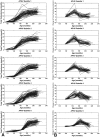Testosterone trajectories and reference ranges in a large longitudinal sample of male adolescents
- PMID: 25268961
- PMCID: PMC4182562
- DOI: 10.1371/journal.pone.0108838
Testosterone trajectories and reference ranges in a large longitudinal sample of male adolescents
Abstract
Purpose: Pubertal dynamics plays an important role in physical and psychological development of children and adolescents. We aim to provide reference ranges of plasma testosterone in a large longitudinal sample. Furthermore, we describe a measure of testosterone trajectories during adolescence that can be used in future investigations of development.
Methods: We carried out longitudinal measurements of plasma testosterone in 2,216 samples obtained from 513 males (9 to 17 years of age) from the Avon Longitudinal Study of Parents and Children. We used integration of a model fitted to each participant's testosterone trajectory to calculate a measure of average exposure to testosterone over adolescence. We pooled these data with corresponding values reported in the literature to provide a reference range of testosterone levels in males between the ages of 6 and 19 years.
Results: The average values of total testosterone in the ALSPAC sample range from 0.82 nmol/L (Standard Deviation [SD]: 0.09) at 9 years of age to 16.5 (SD: 2.65) nmol/L at 17 years of age; these values are congruent with other reports in the literature. The average exposure to testosterone is associated with different features of testosterone trajectories such as Peak Testosterone Change, Age at Peak Testosterone Change, and Testosterone at 17 years of age as well as the timing of the growth spurt during puberty.
Conclusions: The average exposure to testosterone is a useful measure for future investigations using testosterone trajectories to examine pubertal dynamics.
Conflict of interest statement
Figures



References
-
- Sisk CL, Foster DL (2004) The neural basis of puberty and adolescence. Nat Neurosci 7: 1040–1047. - PubMed
-
- Patton GC, Viner R (2007) Pubertal transitions in health. Lancet 369: 1130–1139. - PubMed
-
- Kindblom JM, Lorentzon M, Norjavaara E, Lönn L, Brandberg J, et al. (2006) Pubertal timing is an independent predictor of central adiposity in young adult males: the Gothenburg osteoporosis and obesity determinants study. Diabetes 55: 3047–3052. - PubMed
-
- Hiort O (2002) Androgens and puberty. Best Pr Res Clin Endocrinol Metab 16: 31–41. - PubMed
Publication types
MeSH terms
Substances
Grants and funding
LinkOut - more resources
Full Text Sources
Other Literature Sources

